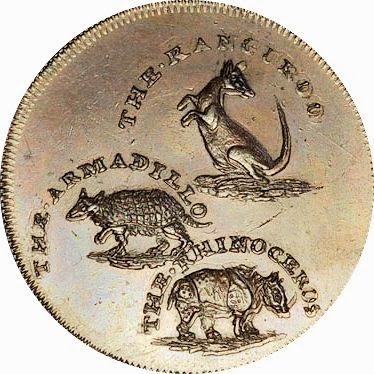How to stuff a Rhinoceros ??
Well I don't know, but Jean's great great great Grandfather did.
This event was commemorated on a number of tokens issued about 1795, one by Thomas Hall and another by Pidcock.
Read the full story in our book Thomas Hall of City Road available on Amazon.co.UK
Well I don't know, but Jean's great great great Grandfather did.
A rhino had been imported in to England 1790
as a gift to Mr. Dundas a Scottish Member of Parliament, who
apparently did not want the bother of keeping it and gave it away.
It was subsequently purchased by Gilbert Pidcock for £700 and was
exhibited at the Exeter Exchange Menagerie in the Strand and also as
an exhibit in Pidcock's travelling menagerie.
The animal is
described as having been very docile, would obey his keeper's orders
and would allow visitors to pat him. In October 1792, in an act of
getting to his feet, the rhino dislocated the joint in one of his
forelegs, which brought on inflammation. This injury resulted in his
death about nine months later, but not before Pidcock, its owner, had
taken out an insurance policy on the animal. The death occurred
whilst the Menagerie was on the move and near the town of Portsmouth,
(some sources state "Corsham near Portsmouth”). The odour
from the remains was such that the Mayor of Portsmouth ordered that
the carcass be buried. About two weeks later, the story goes, the
remains were dug up, at dead of night and was subsequently preserved
by Thomas Hall of City Road.
This event was commemorated on a number of tokens issued about 1795, one by Thomas Hall and another by Pidcock.
Read the full story in our book Thomas Hall of City Road available on Amazon.co.UK


